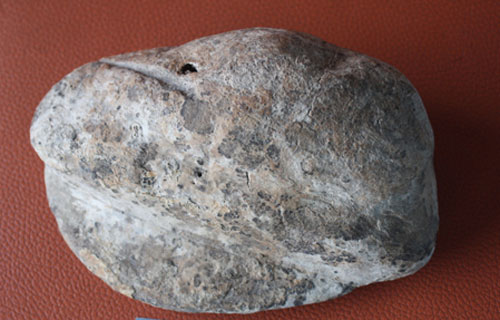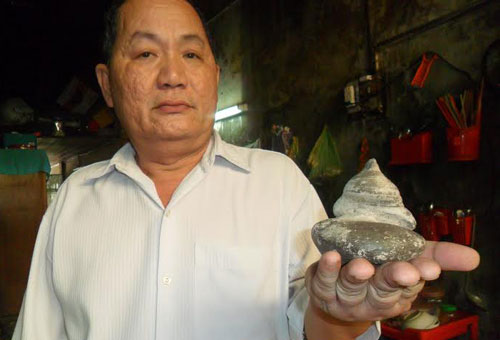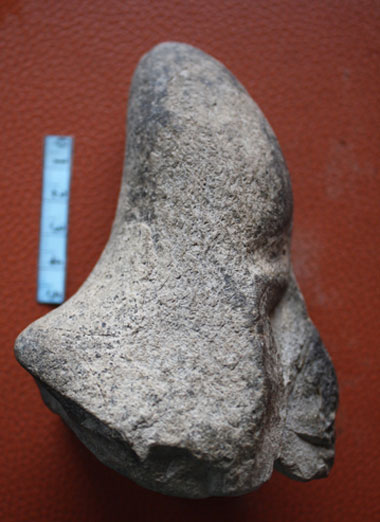People in Kien Giang possess three fossil samples dating back millions of years
Truong Van Chien, 56, in Rach Gia City, owns fossils of two snails dating back 130 million years and of a species in the rhino family for millions of years.
The specimens collected by Mr. Chien from seafood catchers by rake boats in Phu Quoc sea 42 years ago. Recently, Mr. Chien brought this specimen to Hanoi to meet the doctorate of paleontology and Trinh Dac stratigraphy to date.

Microschiza sp.(Photos provided by Mr. Chien)
The two fossilized snails are not preserved intact during the turbulent movement of the seabed for a long time. The shape, size and major structural elements still preserved of the specimen only allow orientation to determine fossils with the same hierarchy.
According to the research results of Dr. Trinh Danh, member of the first General Assembly of Geology and Fossilization with scientific name Microschiza sp . This is the inner mold of a large-sized, soft-legged bark of Microschiza. It is nearly 8cm tall, consists of 6 rolls; Round bottom 4cm high, 7cm diameter. "Fossils may be in the vicinity of Jura-Creta, about 140-130 million years ago," according to the conclusion.

Mr. Nguyen Van Chien and the snail specimen.(Photo: Huu Phuong)
The second fossil of this age has the scientific name of Homomya sp . Fossil is the mold in the left piece of a large bivalve mollusk of Homomya. It is about 11cm long with soft feet protruding from the shell when buried by sediment.
Another animal fossil that Mr. Chien holds is rhino horn. This sample is about 10cm long, the cone shape is slightly curved, blinking, the flared bottom is nearly round with two radial dimensions of 6cm and 5cm.
Based on the shape of the specimen, especially the shell and custom structure shown on the bottom, contrasting with the documents of modern and fossilized rhino horns, Dr. Trinh Dich said that this is a horn. A species of jelly in the rhino family.

The fossil horn of a species in the rhino family.(Photos provided by Mr. Chien)
Because specimens no longer preserve the characteristics that can be identified to species, they can only be identified. The scientific name of the fossil specimen is Rhinocerotidaegen.et sp.indet . "The age of fossils is difficult to determine because there is no accompanying geological data to compare, but according to existing documents it can take millions of years," concluded Dr. Trinh Dich.
"After being assessed and granted a certificate, my family will preserve and preserve for the next generation to admire , " Mr. Chien said, and said he also kept many fossils of other animals like the heart. Goat and fossil snake.
- The discovery of fossilized animal fossils dating back 600,000 years
- Sarus cranes return to live on Kien Giang land
- The Sarus Crane pulled back to Kien Giang
- Seagrass is found in Kien Giang waters
- Kien Giang: Officially announced new plant species discovered
- Excavation of dinosaur fossils dating back 135 million years
- From Quang Ninh to Kien Giang Songda storm room
- Precious dolphins appear in Kien Giang
- 'Fossil' 3.7 billion years old is once again shocking because it seems to be just normal stone
- The discovery of fossil shark eggs dates back to 310 million years
- Seeing a gibbon skull fossil dating from 20 million years
- Kien Giang Sea: World biosphere reserve
 Discovered an ancient centipede fossil 99 million years old
Discovered an ancient centipede fossil 99 million years old Discovered bat-like dinosaurs in China
Discovered bat-like dinosaurs in China Discovered a 200-year-old bronze cannon of the coast
Discovered a 200-year-old bronze cannon of the coast Discover 305 million-year-old spider fossils
Discover 305 million-year-old spider fossils